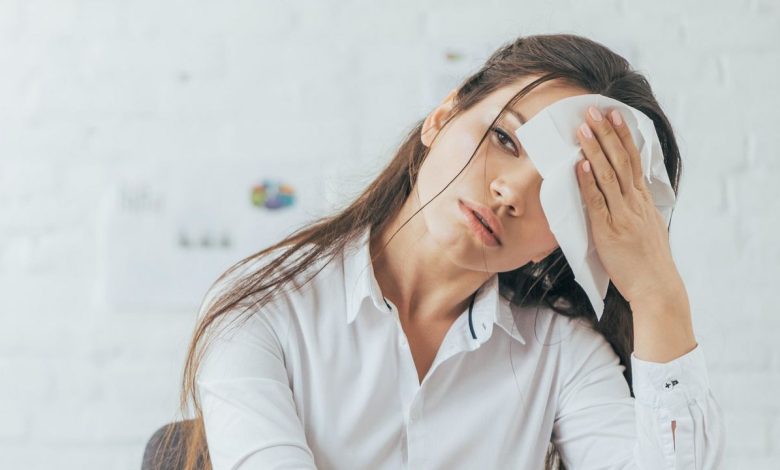Sweating, increased perspiration, hyperhidrosis: What's it, causes, symptoms, diagnostics, treatment, prevention

Sweating; Perspiration
What is excessive sweating?
Increased perspiration, also known as hyperhidrosis, is a medical condition, in which the body produces an excess amount of sweat. This condition can significantly affect the quality of life., causing discomfort, emotional stress and social difficulties. Hyperhidrosis can affect different parts of the body, including armpits, palms, feet or other areas.
Causes of increased sweating
The amount of sweat depends on, how many sweat glands do you have.
Man is born with 2 to 4 million sweat glands, that become fully active at puberty. male sweat glands, usually, more active.
Sweating is controlled by the autonomic nervous system. It's part of the nervous system, which is not under your control. Sweating is the body's natural way of regulating temperature..
Causes, which can make you sweat more, include:
- Hot weather
- Exercise
- Situation, that make you nervous, get angry, be embarrassed or afraid
Heavy sweating can also be a symptom of menopause. (also called "tide").
Other causes of sweating may include:
- Alcohol
- Caffeine
- Cancer
- Reflex sympathetic dystrophy
- Emotional or stressful situations (anxiety)
- Essential hyperhidrosis
- intense exercise
- High body temperature
- Infection
- Low blood sugar (gipoglikemiâ)
- Medicines, such as thyroid hormone, morphine, drugs to reduce fever and drugs to treat mental disorders.
- Menopause
- Spicy food (known as "gustatory sweating")
- High ambient temperature
- Avoiding alcohol, sedative or narcotic pain relievers
Symptoms of increased sweating
Symptoms of hyperhidrosis may include:
- Skin moisture: The skin becomes constantly moist even in the absence of physical activity.
- The need to change clothes frequently: Excessive sweating can lead to the need to change clothes frequently.
- Unpleasant smell: Excessive sweating can be accompanied by an unpleasant odor.
- Redness and irritation of the skin: Constant skin moisture can cause irritation and redness.
- Social and emotional difficulties: Hyperhidrosis can cause shame, anxiety and social isolation.
When to see a doctor
Contact your doctor, if it is observed together with sweating:
- Chest pain
- Heat
- Fast, cardiopalmus
- Breathlessness
- Weight loss
These symptoms may indicate an overactive thyroid or an infection..
Also call your doctor, if:
- You sweat profusely or have unexplained sweating for no apparent reason
- Sweating occurs with or is accompanied by chest pain or pressure
- You lose weight through sweating or sweat frequently while you sleep
Questions, which the doctor may ask
- How long have you experienced excessive sweating?
- Have you had changes in your daily routine or stressful events??
- Are you taking any medication?
- Do you have thyroid disorders or other medical problems??
Diagnosis of heavy sweating
Diagnosis of hyperhidrosis may include:
- Medical examination and discussion of symptoms with a doctor.
- Analysis of medical history to identify factors, sweating.
- Need for more testing to rule out other potential causes of symptoms.
Treatment for excessive sweating
Treatment for hyperhidrosis may involve various methods depending on the severity of the symptoms and their effect on the patient.. Below are some treatments for excessive sweating:
- Antiperspirantы: In most cases, antiperspirants, containing aluminum salts, may be the first line of defense against excessive sweating. They block the sweat glands and reduce sweating.. Antiperspirants can be used on different areas of the body, such as armpits, palms and feet.
- Botulinum Therapy Procedures: Botulinum therapy, also known as botox injections, may be an effective treatment for uncontrolled sweating. The drug is injected into the sweat glands, blocking their function for a certain period of time.
- Iontophoresis: This method involves using a mild electrical current to temporarily block the sweat glands.. Iontophoresis can be used on the palms, feet and other areas.
- Medication: In some cases, the doctor may prescribe oral medications, such as anticholinergic drugs, to reduce sweating.
- Surgical treatment: In cases of severe hyperhidrosis, when conservative methods fail, surgery may be suggested. One of the methods is endoscopic sympathectomy., in which the nerves are blocked, regulating perspiration.
- Laser therapy: The use of a laser may be effective in treating sweating in some cases..
- Professional Stress Management Techniques: Emotional stress may be one of the causes of excessive sweating. Therapy, biofeedback and relaxation techniques can help manage these factors.
Excessive sweating should be treated under medical supervision., who will evaluate the individual characteristics of the patient and select the best method of treatment. Remember, what is the right way to see a doctor, accurate diagnosis and selection of the appropriate treatment strategy will help to significantly improve the quality of life of the patient.
Treatment for severe sweating at home
Home treatment may include:
- Maintain good hygiene and skin care.
- Avoiding highly spicy and hot foods, which may promote sweating.
- Use of cool clothes and shoes.
Prevention of heavy sweating
Recommended for the prevention of hyperhidrosis:
- Adherence to healthy lifestyle.
- Avoiding stressful situations and practicing relaxation techniques.
- Use of antiperspirants and skin care.
It is important to remember, that only a doctor can give an accurate diagnostic conclusion and determine the most appropriate treatment plan for each specific case of severe sweating.
Used sources and literature
Chelimsky T, Chelimsky G. Disorders of the autonomic nervous system. In: Jankovic J, Mazziotta JC, Pomeroy SL, Newman NJ, eds. Bradley and Daroff’s Neurology in Clinical Practice. 8th ed. Philadelphia, PA: Elsevier; 2022:chap 107.
Hall JE, Hall ME. Body temperature regulation and fever. In: Hall JE, Hall ME, eds. Guyton and Hall Textbook of Medical Physiology. 14th ed. Philadelphia, PA: Elsevier; 2021:chap 74.
McGrath JA. The structure and function of skin. In: Calonje E, Brenn T, Lazar AJ, Billings SD, eds. McKee’s Pathology of the Skin. 5th ed. Philadelphia, PA: Elsevier; 2020:chap 1.
